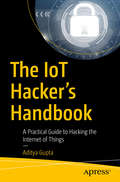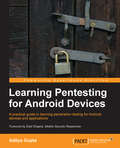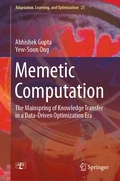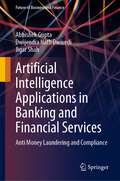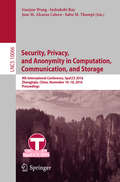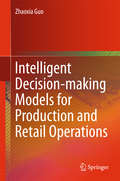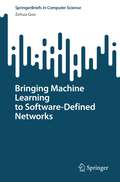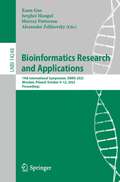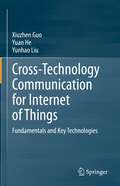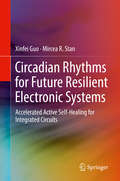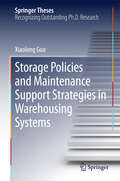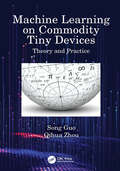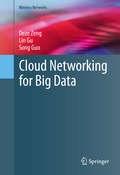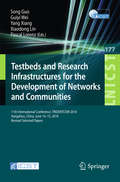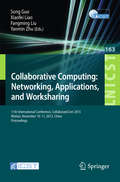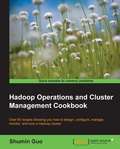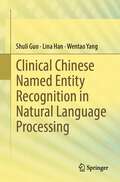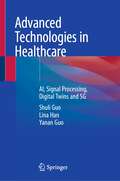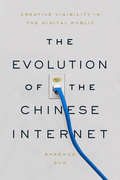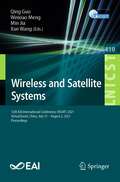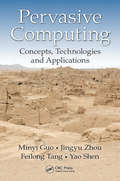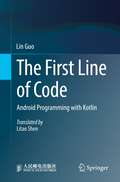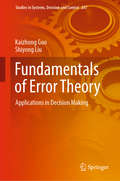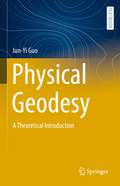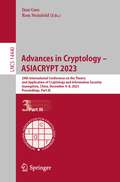- Table View
- List View
The IoT Hacker's Handbook: A Practical Guide to Hacking the Internet of Things
by Aditya GuptaTake a practioner’s approach in analyzing the Internet of Things (IoT) devices and the security issues facing an IoT architecture. You’ll review the architecture's central components, from hardware communication interfaces, such as UARTand SPI, to radio protocols, such as BLE or ZigBee. You'll also learn to assess a device physically by opening it, looking at the PCB, and identifying the chipsets and interfaces. You'll then use that information to gain entry to the device or to perform other actions, such as dumping encryption keys and firmware. As the IoT rises to one of the most popular tech trends, manufactures need to take necessary steps to secure devices and protect them from attackers. The IoT Hacker's Handbook breaks down the Internet of Things, exploits it, and reveals how these devices can be built securely.What You’ll LearnPerform a threat model of a real-world IoT device and locate all possible attacker entry points Use reverse engineering of firmware binaries to identify security issues Analyze,assess, and identify security issues in exploited ARM and MIPS based binariesSniff, capture, and exploit radio communication protocols, such as Bluetooth Low Energy (BLE), and ZigBeeWho This Book is ForThose interested in learning about IoT security, such as pentesters working in different domains, embedded device developers, or IT people wanting to move to an Internet of Things security role.
Learning Pentesting for Android Devices
by Aditya GuptaThis is an easy-to-follow guide, full of hands-on and real-world examples of applications. Each of the vulnerabilities discussed in the book is accompanied with the practical approach to the vulnerability, and the underlying security issue. This book is intended for all those who are looking to get started in Android security or Android application penetration testing. You don't need to be an Android developer to learn from this book, but it is highly recommended that developers have some experience in order to learn how to create secure applications for Android.
Memetic Computation: The Mainspring Of Knowledge Transfer In The Data-driven Optimization Era (Adaptation, Learning, and Optimization #21)
by Abhishek Gupta Yew-Soon OngThis book bridges the widening gap between two crucial constituents of computational intelligence: the rapidly advancing technologies of machine learning in the digital information age, and the relatively slow-moving field of general-purpose search and optimization algorithms. With this in mind, the book serves to offer a data-driven view of optimization, through the framework of memetic computation (MC). The authors provide a summary of the complete timeline of research activities in MC – beginning with the initiation of memes as local search heuristics hybridized with evolutionary algorithms, to their modern interpretation as computationally encoded building blocks of problem-solving knowledge that can be learned from one task and adaptively transmitted to another. In the light of recent research advances, the authors emphasize the further development of MC as a simultaneous problem learning and optimization paradigm with the potential to showcase human-like problem-solving prowess; that is, by equipping optimization engines to acquire increasing levels of intelligence over time through embedded memes learned independently or via interactions. In other words, the adaptive utilization of available knowledge memes makes it possible for optimization engines to tailor custom search behaviors on the fly – thereby paving the way to general-purpose problem-solving ability (or artificial general intelligence). In this regard, the book explores some of the latest concepts from the optimization literature, including, the sequential transfer of knowledge across problems, multitasking, and large-scale (high dimensional) search, systematically discussing associated algorithmic developments that align with the general theme of memetics. The presented ideas are intended to be accessible to a wide audience of scientific researchers, engineers, students, and optimization practitioners who are familiar with the commonly used terminologies of evolutionary computation. A full appreciation of the mathematical formalizations and algorithmic contributions requires an elementary background in probability, statistics, and the concepts of machine learning. A prior knowledge of surrogate-assisted/Bayesian optimization techniques is useful, but not essential.
Artificial Intelligence Applications in Banking and Financial Services: Anti Money Laundering and Compliance (Future of Business and Finance)
by Abhishek Gupta Dwijendra Nath Dwivedi Jigar ShahThis book discusses all aspects of money laundering, starting from traditional approach to financial crimes to artificial intelligence-enabled solutions. It also discusses the regulators approach to curb financial crimes and how syndication among financial institutions can create a robust ecosystem for monitoring and managing financial crimes. It opens with an introduction to financial crimes for a financial institution, the context of financial crimes, and its various participants. Various types of money laundering, terrorist financing, and dealing with watch list entities are also part of the discussion. Through its twelve chapters, the book provides an overview of ways in which financial institutions deal with financial crimes; various IT solutions for monitoring and managing financial crimes; data organization and governance in the financial crimes context; machine learning and artificial intelligence (AI) in financial crimes; customer-level transaction monitoring system; machine learning-driven alert optimization; AML investigation; bias and ethical pitfalls in machine learning; and enterprise-level AI-driven Financial Crime Investigation (FCI) unit. There is also an Appendix which contains a detailed review of various data sciences approaches that are popular among practitioners.The book discusses each topic through real-life experiences. It also leverages the experience of Chief Compliance Officers of some large organizations to showcase real challenges that heads of large organizations face while dealing with this sensitive topic. It thus delivers a hands-on guide for setting up, managing, and transforming into a best-in-class financial crimes management unit. It is thus an invaluable resource for researchers, students, corporates, and industry watchers alike.
Security, Privacy, and Anonymity in Computation, Communication, and Storage: 9th International Conference, SpaCCS 2016, Zhangjiajie, China, November 16-18, 2016, Proceedings (Lecture Notes in Computer Science #10066)
by Guojun Wang, Indrakshi Ray, Jose M. Alcaraz Calero and Sabu M. ThampiThis book constitutes the refereed proceedings of the 9th International Conference on on Security, Privacy and Anonymity in Computation, Communication and Storage, SpaCCS 2016, held in Zhangjiajie, China, in November 2016.The 40 papers presented in this volume were carefully reviewed and selected from 110 submissions. They are organized in topical sections including security algorithms and architectures, privacy-aware policies, regulations and techniques, anonymous computation and communication, encompassing fundamental theoretical approaches, practical experimental projects, and commercial application systems for computation, communication and storage.
Intelligent Decision-making Models for Production and Retail Operations
by Zhaoxia GuoThis book provides an overview of intelligent decision-making techniques and discusses their application in production and retail operations. Manufacturing and retail enterprises have stringent standards for using advanced and reliable techniques to improve decision-making processes, since these processes have significant effects on the performance of relevant operations and the entire supply chain. In recent years, researchers have been increasingly focusing attention on using intelligent techniques to solve various decision-making problems. The opening chapters provide an introduction to several commonly used intelligent techniques, such as genetic algorithm, harmony search, neural network and extreme learning machine. The book then explores the use of these techniques for handling various production and retail decision-making problems, such as production planning and scheduling, assembly line balancing, and sales forecasting.
Bringing Machine Learning to Software-Defined Networks (SpringerBriefs in Computer Science)
by Zehua GuoEmerging machine learning techniques bring new opportunities to flexible network control and management. This book focuses on using state-of-the-art machine learning-based approaches to improve the performance of Software-Defined Networking (SDN). It will apply several innovative machine learning methods (e.g., Deep Reinforcement Learning, Multi-Agent Reinforcement Learning, and Graph Neural Network) to traffic engineering and controller load balancing in software-defined wide area networks, as well as flow scheduling, coflow scheduling, and flow migration for network function virtualization in software-defined data center networks. It helps readers reflect on several practical problems of deploying SDN and learn how to solve the problems by taking advantage of existing machine learning techniques. The book elaborates on the formulation of each problem, explains design details for each scheme, and provides solutions by running mathematical optimization processes, conducting simulated experiments, and analyzing the experimental results.
Bioinformatics Research and Applications: 19th International Symposium, ISBRA 2023, Wrocław, Poland, October 9–12, 2023, Proceedings (Lecture Notes in Computer Science #14248)
by Xuan Guo Serghei Mangul Murray Patterson Alexander ZelikovskyThis book constitutes the refereed proceedings of the 19th International Symposium on Bioinformatics Research and Applications, ISBRA 2023, held in Wrocław, Poland, during October 9–12, 2023.The 28 full papers and 16 short papers included in this book were carefully reviewed and selected from 89 submissions. They were organized in topical sections as follows: reconciling inconsistent molecular structures from biochemical databases; radiology report generation via visual recalibration and context gating-aware; sequence-based nanobody-antigen binding prediction; and hist2Vec: kernel-based embeddings for biological sequence classification.
Cross-Technology Communication for Internet of Things: Fundamentals and Key Technologies
by Xiuzhen Guo Yuan He Yunhao LiuCross-technology communication (CTC) is a technology that enables direct communication between heterogeneous devices that use different wireless standards. It works like a “translator” between two or more wireless technologies. CTC not only creates a new avenue for inter-operation and data exchange between wireless devices but also enhances the ability to manage wireless networks. This book focuses on the enabling technology CTC and introduces readers to a variety of CTC techniques in heterogeneous wireless networks. These techniques can be divided into two categories: packet-level CTCs based on energy modulation and channel intervention; and physical-level CTCs based on cross-demapping, digital emulation, and split encoding. The book offers a comprehensive comparison and analysis, granting readers a deeper understanding of CTC techniques in terms of throughput, reliability, hardware modification, and concurrency. Moreover, it highlights upper-layer CTC application scenarios and cutting-edge developments, which include but are not limited to interference management, channel quality estimation, network routing, etc. The book is intended for all readers – e.g., researchers, students, and even professionals – who are interested in the areas of wireless networking, wireless communication, mobile computing, and Internet of Things. The findings and summaries presented here can help: 1) guide researchers to rethink CTC techniques in connection with design methodology; 2) further advance the infrastructure of future IoT by introducing CTC; and 3) enable important IoT applications by delivering ubiquitous network connectivity.
Circadian Rhythms for Future Resilient Electronic Systems: Accelerated Active Self-Healing for Integrated Circuits
by Xinfei Guo Mircea R. StanThis book describes methods to address wearout/aging degradations in electronic chips and systems, caused by several physical mechanisms at the device level. The authors introduce a novel technique called accelerated active self-healing, which fixes wearout issues by enabling accelerated recovery. Coverage includes recovery theory, experimental results, implementations and applications, across multiple nodes ranging from planar, FD-SOI to FinFET, based on both foundry provided models and predictive models. Presents novel techniques, tested with experiments on real hardware;Discusses circuit and system level wearout recovery implementations, many of these designs are portable and friendly to the standard design flow;Provides circuit-architecture-system infrastructures that enable the accelerated self-healing for future resilient systems;Discusses wearout issues at both transistor and interconnect level, providing solutions that apply to both;Includes coverage of resilient aspects of emerging applications such as IoT.
Storage Policies and Maintenance Support Strategies in Warehousing Systems
by Xiaolong GuoThis book studies storage policies in warehousing systems and maintenance-support strategies for critical operational systems in warehouses, which are the most important issues affecting operational efficiency of warehousing systems. It expands on the theory of class-based storage by considering a finite number of items in store, and also introduces the maintenance-support strategy founded on performance-based contract theory. It is a valuable resource for researchers, practitioners and engineers in the fields of industrial engineering, operations management, operations research and management science.
Machine Learning on Commodity Tiny Devices: Theory and Practice
by Song Guo Qihua ZhouThis book aims at the tiny machine learning (TinyML) software and hardware synergy for edge intelligence applications. It presents on-device learning techniques covering model-level neural network design, algorithm-level training optimization, and hardware-level instruction acceleration.Analyzing the limitations of conventional in-cloud computing would reveal that on-device learning is a promising research direction to meet the requirements of edge intelligence applications. As to the cutting-edge research of TinyML, implementing a high-efficiency learning framework and enabling system-level acceleration is one of the most fundamental issues. This book presents a comprehensive discussion of the latest research progress and provides system-level insights on designing TinyML frameworks, including neural network design, training algorithm optimization and domain-specific hardware acceleration. It identifies the main challenges when deploying TinyML tasks in the real world and guides the researchers to deploy a reliable learning system.This volume will be of interest to students and scholars in the field of edge intelligence, especially to those with sufficient professional Edge AI skills. It will also be an excellent guide for researchers to implement high-performance TinyML systems.
Cloud Networking for Big Data (Wireless Networks)
by Song Guo Deze Zeng Lin GuThis book introduces two basic big data processing paradigms for batch data and streaming data. Representative programming frameworks are also presented, as well as software defined networking (SDN) and network function virtualization (NFV) technologies as key cloud networking technologies. The authors illustrate that SDN and NFV can be applied to benefit the big data processing by proposing a cloud networking framework. Based on the framework, two case studies examine how to improve the cost efficiency of big data processing. Cloud Networking for Big Data targets professionals and researchers working in big data, networks, wireless communications and information technology. Advanced-level students studying computer science and electrical engineering will also find this book valuable as a study guide.
Testbeds and Research Infrastructures for the Development of Networks and Communities
by Song Guo Guiyi Wei Yang Xiang Xiaodong Lin Pascal LorenzThis book constitutes the refereed proceedings of the 11th International Conference on Testbeds and Research Infrastructures for the Development of Networks and Communities, TridentCom 2016, held in Hangzhou, China, in June 2016. The 16 papers were carefully selected from 25 submissions and provide a forum about technologies of big data, cyber physical systems and computer communications. The papers consist of 4 sessions covering future Internet and software defined network, network testbed design and implementation, testbed for network applications, and QoS/QoE on networks.
Collaborative Computing: 11th International Conference, CollaborateCom 2015, Wuhan, November 10-11, 2015, China. Proceedings (Lecture Notes of the Institute for Computer Sciences, Social Informatics and Telecommunications Engineering #163)
by Song Guo Xiaofei Liao Fangming Liu Yanmin ZhuThisbook constitutes the thoroughly refereed proceedings of the 11th InternationalConference on Collaborative Computing: Networking, Applications, andWorksharing, CollaborateCom 2015, held in Wuhan, China, in November 2015. The 24 full papers and 8 short papers presented were carefullyreviewed and selected from numerous submissions. They address topics aroundnetworking, technology and systems, including but not limited to collaborativecloud computing, architecture and evaluation, collaborative applications,sensors and Internet of Things (IoT), security.
Hadoop Operations and Cluster Management Cookbook
by Shumin GuoSolve specific problems using individual self-contained code recipes, or work through the book to develop your capabilities. This book is packed with easy-to-follow code and commands used for illustration, which makes your learning curve easy and quick.If you are a Hadoop cluster system administrator with Unix/Linux system management experience and you are looking to get a good grounding in how to set up and manage a Hadoop cluster, then this book is for you. It's assumed that you will have some experience in Unix/Linux command line already, as well as being familiar with network communication basics.
Clinical Chinese Named Entity Recognition in Natural Language Processing
by Shuli Guo Lina Han Wentao YangThis book introduces how to enhance the context capture ability of the model, improve the position information perception ability of the pretrained models, and identify and denoise the unlabeled entities. The Chinese medical named entity recognition is an important branch of the intelligent medicine, which is beneficial to mine the information hidden in medical texts and provide the medical entity information for clinical medical decision-making and medical classification. Researchers, engineers and post-graduate students in the fields of medicine management and software engineering.
Advanced Technologies in Healthcare: AI, Signal Processing, Digital Twins and 5G
by Shuli Guo Lina Han Yanan GuoThis book explores the applications of cutting-edge technologies such as AI, blockchain, signal processing, digital twin technology, and 5G communication technology in healthcare. The writing style combines diagrams, tables, formulae, and text to enhance readability. The content combines theoretical analysis and medical application in every chapter. This book presents several innovative methods, including an AI-based computer-aided diagnosis system, a blockchain-based AI system framework for healthcare, pre-processing algorithms for medical imaging, digital twin models for healthcare, a healthcare platform based on cloud, fog, and edge computing, and a personal health device domain information model. This book will be valuable for researchers, engineers, and post-graduate students in the fields of medicine management and software engineering.
The Evolution of the Chinese Internet: Creative Visibility in the Digital Public
by Shaohua GuoDespite widespread consensus that China's digital revolution was sure to bring about massive democratic reforms, such changes have not come to pass. While scholars and policy makers alternate between predicting change and disparaging a stubbornly authoritarian regime, in this book Shaohua Guo demonstrates how this dichotomy misses the far more complex reality. The Evolution of the Chinese Internet traces the emergence and maturation of one of the most creative digital cultures in the world through four major technological platforms: the bulletin board system, the blog, the microblog, and WeChat. Guo transcends typical binaries of freedom and control, to argue that Chinese Internet culture displays a uniquely sophisticated interplay between multiple extremes, and that its vibrancy is dependent on these complex negotiations. In contrast to the flourishing of research findings on what is made invisible online, this book examines the driving mechanisms that grant visibility to particular kinds of user-generated content. Offering a systematic account of how and why an ingenious Internet culture has been able to thrive, Guo highlights the pivotal roles that media institutions, technological platforms, and creative practices of Chinese netizens have played in shaping culture on- and offline.
Wireless and Satellite Systems: 12th EAI International Conference, WiSATS 2021, Virtual Event, China, July 31 – August 2, 2021, Proceedings (Lecture Notes of the Institute for Computer Sciences, Social Informatics and Telecommunications Engineering #410)
by Qing Guo Weixiao Meng Min Jia Xue WangThis book constitutes the refereed post-conference proceedings of the 12th International Conference on Wireless and Satellite Services, WiSATS 2021, held in Nanjing, China, in September 2020. Due to COVID-19 pandemic the conference was held virtually. The 79 full papers were carefully reviewed and selected from 140 submissions. The conference’s central theme is the means of using the wireless and satellite services directly to the user for personal communications, multimedia and location identification. The services enabled by WiSATS not only cover the requirements of an ordinary citizen but also provide personal and public services for global coverage communications as the applications of internet of things.
Pervasive Computing: Concepts, Technologies and Applications (Lecture Notes in Computer Science #6646)
by Minyi Guo Jingyu Zhou Feilong Tang Yao ShenThis book introduces fundamental concepts and theories in pervasive computing as well as its key technologies and applications. It explains how to design and implement pervasive middleware and real application systems, covering nearly all aspects related to pervasive computing. Key technologies in the book include pervasive computing-oriented resource management and task migration, mobile pervasive transaction, human computer interface, and context collection-oriented wireless sensor networks.
The First Line of Code: Android Programming with Kotlin
by Lin GuoThe First Line of Code is a must-have for developers who want to learn Android and Kotlin, and the best-seller in China. Knowledge between Android and Kotlin is interspersed in a way that readers are easy to understand and get start:· Android part covers all the important aspects of the Android platform, such as activity, service, content provider, broadcast receiver, fragment, basic UI, data storage, network, Jetpack and other application-level knowledge. · Kotlin part covers various aspects of Kotlin, such as standard grammar, common skills, higher-order functions, generics, coroutines, DSL and other language-level knowledge. In addition, The First Line of Code is a very practicing book, illustrating concepts with a complete weather forecast program. You can use and practice all the knowledge comprehensively after learning and see the actual result for what you have learned through the book. All contents of the book are quite easy to understand. It might be a good choice for both beginners and experienced developers. Also suitable for college students, college teachers, etc.
Fundamentals of Error Theory: Applications in Decision Making (Studies in Systems, Decision and Control #267)
by Kaizhong Guo Shiyong LiuThis book provides a tool for generic readers and graduates who are interested or majoring in systems engineering, decision science, management science, and project management to sharpen their system thinking skills, equipping them with a multiangle perspective, and offering them broader view to understand the complex socioeconomic system in which we are embedded. It systematically investigates the root causes and mechanisms that generate errors through the use of fuzzy set theory, systems science, logic and set theory, and decision science – an area that has rarely been explored in literature. The topics covered include classic error set, fuzzy error set, multivariate error set, error function, identification of errors, error systems, error logic, error matrix, and practical application of error theory in a sewage project.
Physical Geodesy: A Theoretical Introduction (Springer Textbooks in Earth Sciences, Geography and Environment)
by Jun-Yi GuoThis textbook introduces physical geodesy. It treats the boundary-value theories of the discipline comprehensively, and provides insights to the theory of gravity reduction based on a spherical Earth model. This book is for students who wish to thoroughly understand the material and to expand their knowledge and skills in mathematics for more advanced study and research in this discipline. The details of mathematical derivations included are a useful asset for instructors and researchers.
Advances in Cryptology – ASIACRYPT 2023: 29th International Conference on the Theory and Application of Cryptology and Information Security, Guangzhou, China, December 4–8, 2023, Proceedings, Part III (Lecture Notes in Computer Science #14440)
by Jian Guo Ron SteinfeldThe eight-volume set LNCS 14438 until 14445 constitutes the proceedings of the 29th International Conference on the Theory and Application of Cryptology and Information Security, ASIACRYPT 2023, held in Guangzhou, China, during December 4-8, 2023.The total of 106 full papers presented in these proceedings was carefully reviewed and selected from 375 submissions. The papers were organized in topical sections as follows: Part I: Secure Multi-party computation; threshold cryptography; . Part II: proof systems - succinctness and foundations; anonymity; Part III: quantum cryptanalysis; symmetric-key cryptanalysis; Part IV: cryptanalysis of post-quantum and public-key systems; side-channels; quantum random oracle model; Part V: functional encryption, commitments and proofs; secure messaging and broadcast; Part VI: homomorphic encryption; encryption with special functionalities; security proofs and security models; Part VII: post-quantum cryptography; Part VIII: quantum cryptography; key exchange; symmetric-key design.
